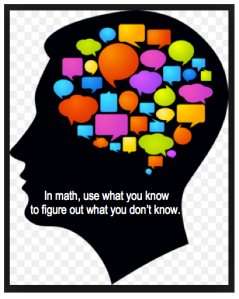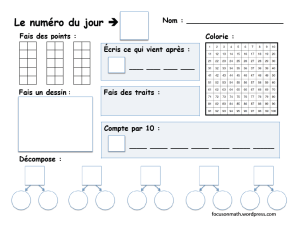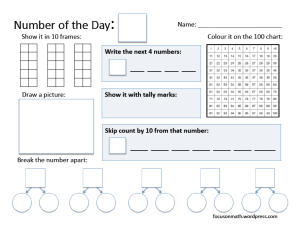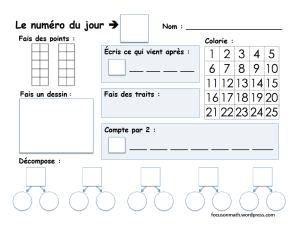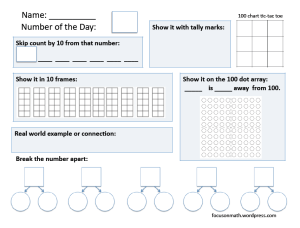 Today I am posting the third Number of the Day sheet. I cannot overstate that I believe that elementary school students should be involved with numbers everyday they are in school!
Today I am posting the third Number of the Day sheet. I cannot overstate that I believe that elementary school students should be involved with numbers everyday they are in school!
Level III is one to primarily use with numbers to 100. The section “100 chart tic-tac-toe” will not be familiar to most. I had devised that math game based on the positioning of a number on the 100 chart. For instance, if 26 is written in the centre of the chart, then the middle line is to show one more and one less than 26. (25, 26, 27 across). Above the middle number is 10 less, in this case 16. Below 26 is 10 more, 36 in this case. The corners can then be filled in using the horizontal or vertical relationships already established. (For more on the use of 100 chart tic-tac-toe, see my previous blog post.)
When using 100 dot arrays, I have students use highlighters to colour the numbers. I also stress marking efficiently – we do NOT colour each individual dot; rather a line or partial line is coloured with a swipe of the marker.
At every level breaking apart the number of the day is an important component of the sheet. Quoting John Van de Walle once again, “To conceptualize a number as being made up of two or more parts is the most important relationship that can be developed about numbers.” [Van de Walle, J. and Folk, S. (2005). Elementary and Middle School Mathematics: Teaching Developmentally (Canadian Edition). Pearson: Toronto.]
I did have one teacher ask a question about the breaking apart section. She was used to having students only break apart numbers according to tens and ones. Thus 26 could be broken apart as 20 and 6 or 10 and 16. But sometimes it is easier to work with numbers when we break them in ways other than ten and ones. Consider the thinking that might happen when adding 26 + 27. If a student knows that 26 comes apart as 25 an 1 and that 27 comes apart as 25 and 2, it is easy to put the 25′s together to get 50, then add the 1 and the 2 —total 53. Students who use the 100 dot array often get especially comfortable with 25′s. Also consider adding 97 and 36. If a student notices that 97 is just 3 away from 100, it makes sense to split 36 as 3 and 33. Breakng apart in tens and ones are definitely useful, but so are other “break-aparts”. If students do not practice this kind of thinking they are not likely to ever do it!
I had one teacher here in my district that was using this sheet and her students were getting tired of making tallies for large numbers. So I am including a second English version of the sheet asking for equations for the number instead.
Again, a French version is offered as well with thanks to my friend and colleague Lynn St. Louis for her translation.
Download the English version (tallies) here.
Download the English version (equations) here.
Download the French version here.
Mathematically yours,
Carollee

 π is one of the most widely-known mathematical constants both inside and outside the mathematics/scientific community and it has been around for a very long time!
π is one of the most widely-known mathematical constants both inside and outside the mathematics/scientific community and it has been around for a very long time!




